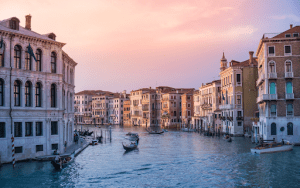BLOGS
Ultimate Guide to Traveling Around Europe
With the pandemic still raging, most people have opted to just travel from the comforts of their homes in the past year. But if we’re talking about actual traveling, Europe is the most visited continent in the world, and it’s not hard to see why. Almost every country in the continent features something interesting for tourists to explore, so they can enjoy either traveling around Europe or focusing on one country at a time.
It’s home to a wide variety of breathtaking landscapes and features. Every country has a diverse and deeply-rooted history, which creates a rich culture for everyone to explore. Most places are safe for traveling, too, even with the pandemic prevailing in other areas.
Whatever your reasons are, traveling around Europe is on everyone’s bucket list. In this article, we’re going to give you a thorough guide on traveling around Europe so that you can stay safe and still enjoy the sights.
Quick Guide to European Travel

An afternoon at Rothenburg ob der Tauber, a town in Germany.
Unless you have a ton of time, you’ll never be able to visit all of Europe’s 44 countries in one go. Thus, when visiting, it’s often helpful to divide Europe into four regions: Eastern, Northern, Southern, and Western Europe.
However, keep in mind that these definitions of which country belongs are hotly debated today. For example, even international authorities like the United Nations have different classifications from the CIA and the European Union.
Nevertheless, each region has different highlights and incredible places to visit, so in this section, we’re going to give you an overview of the four European regions.
Eastern Europe
Historically, Eastern Europe is composed of the countries behind the Iron Curtain, such as the Czech Republic, Poland, and Russia.
This region of the continent most often features historical places and deeply rooted traditions. For example, you can find several World Heritage Sites in the Czech Republic and Montenegro and visit important historical structures like Auschwitz and the State Hermitage Museum.
It’s also generally a cheaper destination than the other regions, so this area of Europe is perfect for budget travelers who are particularly inclined to visit the continent. It can be further subdivided into three smaller regions: the British Isles, the Baltics, and Scandinavia. It’s composed of countries such as the United Kingdom, Denmark, and Iceland, among seven other countries.
This region of Europe is best known as a prime spot to witness the Northern Lights. This phenomenon is a grand natural light show in the northern sky when several conditions are met in winter.
Aside from that, Northern Europe is also known for its natural beauty, modern cities, and rich culture. All three Crosswinds developments, the Alpine Villas, the Grand Quartier, and the Lausanne at Crosswinds, formerly known as the Terraces, actually got their inspiration from the Scandinavian region.

Lausanne at Crosswinds aims to bring Switzerland’s charms closer to Filipinos.
Southern Europe
Southern Europe is composed of 15 countries, which include Croatia, Greece, Italy, and Spain. These countries sit right beside the Mediterranean sea and are some of the most popular places to visit in Spain because of their superb ocean-front views and all-inclusive, high-class resorts.
Aside from great beach weather, this region also features historical sites that you should see while traveling around Europe. Rome, Italy, and even Cyprus all feature ancient ruins and other artifacts that will give you a sense of wonder and reverence.
Many of Brittany’s developments are inspired by Southern Europe. For instance, all Portofino developments, Portofino Heights, Portofino South, and Amore, are based on real-life Southern Europe architecture.
Suggested Read: Which Countries are Open for Travel and Tourism? | Brittany Corporation

Portofino and Amore are both inspired by Italian architecture.
Western Europe
Composed of countries such as Germany, France, and Austria, this region is what most Filipinos think of when they think of “Europe.”
This region has many countries to visit, including iconic locations such as the Eiffel Tower, the Alps, and even the Van Gogh Museum. Even though it’s a hub of European culture that features the best kinds of wineries, art galleries, and ancient ruins, it also boasts some of the most developed cityscapes in the world.
The Belle Reve, found at Brittany Sta. Rosa, is inspired by French-Mediterranean themes, a perfect blend of Southern and Western Europe.
Where to Go when Traveling Around Europe
Now that we know about the four divisions of Europe, maybe you already have an idea of where you want to travel to next? In this section, we’ll discuss some of the most visited European countries today and talk about things you need to keep in mind should you visit.
France

The Eiffel Tower, an iconic spot in Paris, France.
Receiving more than 90 million visitors annually pre-pandemic, France stands as one of the most visited countries, not just in Europe but around the world.
You can write a book about all the reasons there is to visit France, and others have certainly tried. However, among the primary drivers of its tourism industry is its rich culture. We’ve all seen and heard about the grandeur and classical elegance of French cities – it even became one of Brittany’s inspirations for the Belle Reve, as mentioned above.
Their cuisine is one of the most famous in the world as well. Sampling the different regional dishes is something that can’t be missed on your travels. French wine, too, is coveted by people around the globe.
More than that, it’s also home to many cultural heritages and iconic sites. You undoubtedly already have the Eiffel Tower on your travel list, and traveling around Europe simply wouldn’t be right without visiting the Notre-Dame Cathedral, the Palace of Versailles, and the picturesque medieval village of Pérouges, to name a few.
SUGGESTED READ: How to do Luxury Travel with Kids | Luxury Homes by Brittany Corporation
COVID-19 Situation
Adding to the list of why you should visit this lovely country, France has aggressively pursued vaccination campaigns and quarantine protocols. Their efforts have largely resulted in steady drops in their infection rates, which in turn has encouraged the reopening of most leisure establishments.
Popular cultural destinations such as the Louvre museum, Disneyland Paris, and the Château de Versailles are accessible to the public. Indoor and outdoor dining has resumed, as well as malls, theatres, and nightclubs. For the most part, masks are not required when outside, but some establishments still need mandatory mask-wearing, social distancing, and limited capacities.
France’s economy relies heavily on tourism, so the country is largely accepting visitors from countries outside of Europe. Requirements include proof of vaccination or a negative Covid test (antigen or PCR) 72 hours before entering the country.
Italy

Venice, one of Italy’s most-visited cities.
Visiting Italy is a staple when traveling around Europe. Home to ancient cultural sites, influential art and architecture, and picturesque locations, Italy draws millions of people every year.
Some of the most popular historical sites to visit in these countries include the Leaning Tower of Pisa, the Herculaneum, and the Colosseum.
The country also features grand feats of both modern and classical architecture; great, ancient cathedrals such as the Saint Mark’s Basilica, Florence Cathedral, and the Santa Maria delle Grazie abound in different parts of Italy. The charm of Italy’s modern buildings has even been captured by Brittany while developing the Vista Alabang development and its enclaves.
There’s also Rome, home of the Vatican and its deeply-rooted culture and traditions, as well as Florence, Milan, and Venice – all beautiful cities to explore in their own rights.
COVID-19 Situation
Italy is seeing steady declines in its infection numbers. More than half of the population has already been vaccinated at least once. As a result, hospitalizations and deaths have drastically gone down.
Despite pandemic fatigue, many Italians are now optimistic for the future. The country has a white-yellow-orange-red color system to regulate its pandemic response, and most of its 20 regions are on the “yellow” scale. Last May, the country’s Prime Minister gave an energizing speech that assured most of the country will be open for the tourism season. This has fueled an optimistic climate among the local businesses.
Visitors from low-risk countries are required to quarantine for 10 days and show a negative Covid test, with a few exceptions. Only essential travel is allowed (medical care, business, or study) from countries designated as high-risk such as the Philippines, and no travel at all is allowed from Brazil or India.
SUGGESTED READ: Iconic Travel Spots to Visit in the Philippines
Spain

A typical afternoon with Spain’s golden sunset.
Sporting over 47 world heritage sites, you won’t run out of beautiful historical places to visit in Spain.
One of the most popular cities to visit is Barcelona, home of beautiful architecture. This includes the Basilica of the Sagrada Familia, the Gothic Quarter, and the Palace of Catalan Music.
You can also go to Madrid, which is a popular day tour destination where you can hop from historic landmarks, museums, and shows. The architectural wonders of Seville and the natural beauty of Palma de Mallorca are also must-sees when traveling around Europe.
COVID-19 Situation
Although the country is pursuing a very aggressive and accelerated vaccination program, Spain’s infection rates have been rising since June.
However, the country’s Prime Minister has forecasted that 70% of its citizens would be vaccinated this month. The country has one of the most thorough and modern health care systems available for the public, so this shouldn’t be as much of a concern for potential tourists.
Mask rules are still enforced throughout the country, but aside from that protocols and regulations largely depend on each region. Thus, regulations differ in every region and will often change by the week. Nevertheless, most regions in Spain have a pretty bustling local economy, with most leisure establishments open.
Spain is open to vaccinated individuals that come from low-risk countries. However, foreigners coming from high-risk countries such as the Philippines must submit negative antigen test results, although those who pass from the land border between Spain and Portugal seem to be exempt from this rule.
United Kingdom

The Big Ben, one of the most recognizable London landmarks.
Consisting of England, Northern Ireland, Scotland, and Wales, the UK is another one of the most popular tourist destinations in Europe. That’s why Brittany decided to model the Promenade after the English countryside, perfectly capturing its unique charm.
Visitors will be delighted with its many historical sites. The United Kingdom has played an important role in the history of Europe, and with this role comes a large number of historical relics.
Palaces, castles, and churches remain standing as a testament to the periods they were created. The most popular ones to visit are the Stirling Castle, Canterbury Cathedral, Roman Baths, and the ever-famous Stonehenge.
Other than historical sites, the UK is also a hub of modern culture. London is one of the world’s centers for art and fashion, so urbanites will find lots of places to explore. Traveling around Europe isn’t complete without visiting Buckingham Palace, Big Ben, the London Aquarium, and the London Eye.
COVID-19 Situation
More than half of the country’s population has been fully vaccinated, and the government is ready to be ambitious in its vaccination programs.
Social distancing and capacity limitations still apply, but otherwise, most leisure establishments, such as hotels, theaters, restaurants, and pubs, have already reopened. Masks are not required outside, but it’s necessary indoors unless eating or drinking. Although plans to fully reopen large events have been pushed by a new variant in the country, the climate remains largely optimistic.
The UK has a “traffic light” classification for those who wish to enter the country.
Among red-listed countries like the Philippines, only nationals and residents are allowed to enter. For countries on the amber list, travelers are made to show a negative Covid test 72 hours before they leave for the country, and you’ll have to undergo a quarantine period of 10 days. Further tests on the second and tenth dates of quarantine are required as well.
Lastly, visitors coming from green-listed countries, such as New Zealand and Australia, are only required to take a test before departure for the UK and another one-two days after arrival.
Aside from that, there are constant spot checks to check obedience to quarantine rules, and strict fines will be enacted for those who don’t follow. Country classification is reviewed every three weeks.
Protecting Yourself from COVID-19 While traveling Around Europe

The COVID-19 is still raging so be sure to take precautions when traveling.
Traveling around Europe is still possible, provided that you follow the local laws and regulations. More than that, to protect yourself and others from the virus, take heed of the following travel tips:
As much as possible, be fully vaccinated before you travel.
Seek out and follow local guidelines and travel restrictions against the virus.
Always practice social distancing, wherever you are.
Inform the staff or crew should you ever fall ill while traveling.
Religiously follow suggested quarantine protocols.
Regularly wash your hands with your rubbing alcohol or alcohol-based hand sanitizers.
Refrain from traveling if you display symptoms of infection, such as cough, sore throat, body pains, and other symptoms associated with COVID-19.
If you’re older or have any serious underlying conditions, you should reevaluate your need to travel. If travel is unavoidable, take precautionary measures and follow guidelines religiously.
Traveling Around Europe During the Pandemic
The pandemic has pretty much stopped international travel, but several European countries are now steadily reopening to the world. Traveling around Europe isn’t just a pipe dream anymore, and Brittany wants you to live your dreams as much as you can.
However, be sure to follow safety measures and don’t break any rules during your travels. It’s not just for your safety, but the protection of the people around you as well.
Here at Brittany, we take a lot of inspiration from famous European countries.
If you want to experience the magnificence of Switzerland, you can visit Tagaytay’s Crosswinds. The Belle Reve in Brittany Sta Rosa lets you live with the beautiful French buildings all around you, and Vista Alabang captures the beauty of Italy with its atmosphere and architecture. You can even enjoy the quaint charms of the English countryside by living in Brittany’s Promenade.
Nothing beats visiting the real thing, of course, but while you’re in the Philippines, you can have the best of both worlds if you choose one of our top-quality themed developments at Brittany.



















